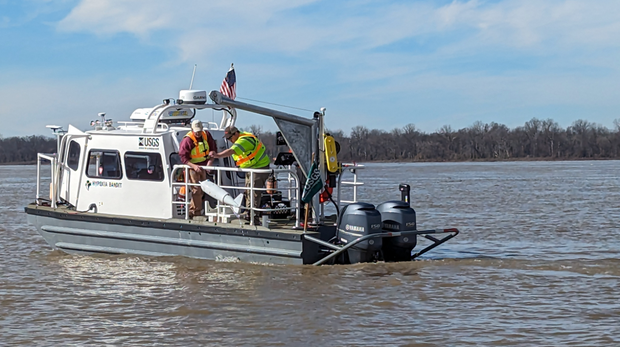CBS News
Connecticut-sized “dead zone” expected to emerge in Gulf of Mexico, potentially killing marine life, NOAA warns

Nearly 6,000 square miles – an area roughly the size of Connecticut – will become a “dead zone” for marine life in the Gulf of Mexico this summer, the National Oceanic and Atmospheric Administration (NOAA) warned on Thursday. Although such areas happen every summer, this year’s will be more than 600 square miles larger than average.
Dead zones are areas in the water where oxygen levels are so low that they can kill fish and other marine life. These zones typically emerge because of excessive nutrient pollution caused by human activities, NOAA said. The average dead zone over the past 37 years has measured at about 5,200 square miles, but this year’s is estimated to be about 5,827 square miles.
The largest dead zone ever recorded in the Gulf was nearly 9,000 square miles – roughly the size of New Jersey – and emerged in 2017. When that happened, videos showed the water becoming so dark that divers needed flashlights to look around.
The estimate comes after the U.S. Geological Survey found about 5% more discharge in the Mississippi and Atchafalaya Rivers than the long-term average in May. Nitrate and phosphorus contribute to algal blooms, and in May, those loads were 7% and 22% above the long-term averages, respectively.
USGS
Those nutrients, though necessary in some amounts, can overload the environment. According to Carleton College’s Science Education Resource Center, runoff filled with fertilizers, soil erosion, animal wastes, and sewage ends up in the aforementioned rivers.
“In a natural system, these nutrients aren’t significant factors in algae growth because they are depleted in the soil by plants. However, with anthropogenically increased nitrogen and phosphorus input, algae growth is no longer limited,” the college says. “Consequently, algal blooms develop, the food chain is altered, and dissolved oxygen in the area is depleted.”
When that happens, it forces many animals, like fish and shrimp, to leave the area, and can kill organisms that are not able to leave. When dead zones are particularly large, they can wreak havoc on fishermen and coastal economies, Carleton College researchers say, as the Gulf provided nearly three-quarters of the country’s harvested shrimp. The Gulf also provides 66% of harvested oysters and 16% of commercial fish.
USGS Lower Mississippi Gulf Water Science Center
“Reducing the impact of hypoxic events and lessening the occurrence and intensity of future dead zones continues to be a NOAA priority,” National Ocean Service Assistant Administrator Nicole LeBoeuf said. “These forecasts are designed to provide crucial data to scientists, coastal managers and communities, and are used as guideposts in the development of planning actions.”
Reducing runoff is essential in minimizing the dead zone.
The National Wildlife Federation said that adopting better agricultural practices, such as planting cover crops and reducing farm field drainage into rivers, as well as filling floodplains with wetlands to filter nutrients, can all be valuable ways to manage the issue.
CBS News
Here Comes the Sun: Jack Antonoff and more

Watch CBS News
Be the first to know
Get browser notifications for breaking news, live events, and exclusive reporting.
CBS News
Capturing Moriah Wilson’s Killer – CBS News

Watch CBS News
Be the first to know
Get browser notifications for breaking news, live events, and exclusive reporting.
CBS News
How to watch the Minnesota Vikings vs. Chicago Bears NFL game today: Livestream options, more

Getty Images
The Minnesota Vikings will take on the Chicago Bears today. The Vikings are currently 8-2, an impressive run so far this season, and will be looking to add a fourth win to their current streak after last Sunday’s 23-13 win against the Tennessee Titans. The Bears, on the other hand, are entering this game on the heels of a four-game losing streak after a tough 20-19 loss against the Green Bay Packers last Sunday.
Here’s how and when you can watch the Vikings vs. Bears game today, whether or not you have cable.
How and when to watch the Minnesota Vikings vs. Chicago Bears
The Vikings vs. Bears game will be played on Sunday, November 24, 2024 at 1:00 p.m. ET (11:00 a.m. PT). The game will air on Fox and stream on Fubo and the platforms featured below.
How and when to watch the Minnesota Vikings vs. Chicago Bears game without cable
You can watch this week’s NFL game on Fox via several streaming services. All you need is an internet connection and one of the top options outlined below.
Fubo offers you an easy, user-friendly way to watch NFL games on CBS, Fox, NBC, ABC, ESPN, and NFL Network, plus NCAA football channels. The Pro tier includes 200+ channels and unlimited DVR, while the Elite with Sports Plus tier adds NFL RedZone and 4K resolution. New subscribers get a seven-day free trial and all plans allow streaming on up to 10 screens simultaneously.
You can watch today’s game with a subscription to Sling’s Orange + Blue tier, which includes ESPN, ABC, NBC, and Fox. The plan offers 46 channels with local NFL games, nationally broadcast games and 50 hours of DVR storage. For complete NFL coverage, add Paramount+ to get CBS games, or upgrade with the Sports Extra add-on for additional sports channels like Golf Channel, NBA TV and NFL RedZone.
Watching NFL games, including Fox broadcasts, is simple with Hulu + Live TV, which includes 90 channels, unlimited DVR storage, and access to NFL preseason games, live regular season games and studio shows. The service includes ESPN+ and Disney+ in the subscription.
Want to watch today’s game live on your smartphone? If so, NFL+ streaming service is the solution you’re looking for. It lets you watch NFL Network and out-of-market games on mobile devices, with an upgrade option to NFL+ Premium that includes NFL RedZone for watching up to eight games simultaneously. Note that NFL+ only works on phones and tablets, not TVs.










